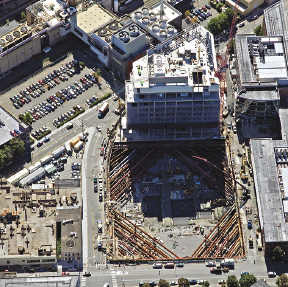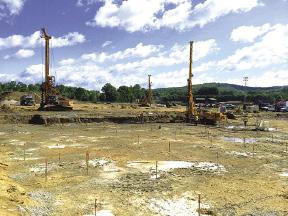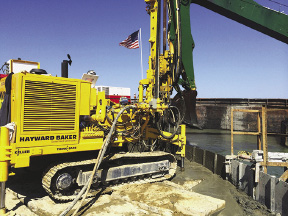Real estate development in New England often faces a wide range of subsurface challenges including underlying non-engineered fill, organic deposits, compressible marine silts/clays, liquefiable sands, glacial till laden with boulders, and high groundwater levels. A variety of geotechnical construction techniques exist for these problem sites; however, the soil conditions dictate which techniques are most appropriate for the job. What options do developers and owners have when remediating poor soils on a strict schedule and budget?
Hayward Baker Inc. (HB), North America's leader in geotechnical construction, offers a comprehensive range of full design-build pre and post-construction services for any geotechnical construction challenge, including foundation rehabilitation, settlement control, liquefaction mitigation, soil stabilization, groundwater control, slope stability, excavation support, underpinning, and environmental remediation. HB, annually ranked by Engineering News-Record (ENR) as #1 in the profession, has over 25 offices servicing North and Central America. Since inception, HB has established itself in the forefront of geotechnical specialty contracting, evolving and expanding to meet the increasingly complex needs of the construction community. HB has the local experience and innovation to assist engineers, contractors, owners and developers with identifying and constructing the most economical solution that satisfies the technical requirements of each project, typical or unique.
Maturity within our safety culture has moved HB beyond simple compliance and towards a culture of commitment. HB's ultimate goal is to have zero incidents through the effective management of safety in all operations.
Ground Improvement
With more than 60 years of experience, knowledge, and skill, HB provides a comprehensive range of ground improvement techniques, having introduced many of the techniques to the U.S. market. Subsurface conditions can vary greatly within a single job site and the characteristics of the in situ soil play a crucial role in determining which ground improvement technique or group of techniques is most effective.
Our national network of offices and full service equipment yards extends our services beyond a restrictive range of techniques and allows HB to provide the full range of ground improvement solutions anywhere in North America, which includes:
* Vibro Systems
* Vibro Piersâ„¢
* Jet grouting
* Dry and wet soil mixing
* Dynamic compaction
* Injection systems for expansive soils
* Rapid impact compaction and
* Rigid inclusions
The effectiveness of each technology relies on a thorough understanding of the subsurface conditions, as well as the fundamental mechanics of the ground improvement system itself. Due to our large variety of solutions, HB offers our clients the most effective ground improvement solution to support your structures.
Earth Retention
and Underpinning
Hayward Baker has experience with the full range of earth retention and underpinning technologies, which have evolved from relatively simple methods of shoring to complex subterranean reinforcement for permanent deep excavation support and stabilization of slopes. When excavations are planned near existing structures, HB can apply earth retention and underpinning techniques to support adjacent structures. HB's design-build earth retention systems include:
* Soldier piles & lagging walls
* Steel sheet pile walls
* Secant pile walls
* Soil nail walls
* Soil mix walls
* Tiebacks and ground anchors
* Hand excavated and jet grouted underpinning
Crucial to the success of these technologies is a thorough understanding of local geotechnical subsurface conditions as well as the structural mechanics of the retention system itself. Having a large variety of solutions allows HB to offer the client the most economical earth retention solution to match relevant soil conditions.
HB has the experience and innovation to assist engineers, contractors, owners, and developers with identifying, developing, and implementing the best earth retention system.
Piling
HB's New England office, located in Providence, Rhode Island, is certified in the Precast/Prestressed Concrete Institute (PCI) Plant Certification Program.
Driven piles are deep foundation elements driven to a design depth or resistance. Types include timber, pre-cast concrete, steel H-piles, and pipe piles. The finished foundation element resists compressive, uplift and lateral loads. HB has installed piling to support buildings, tanks, towers, and bridges, as well as to provide lateral support for earth retention walls and provide slope reinforcement. If penetration of dense soil is required, HB has the capability to predrill, allowing the pile to penetrate to the design depth.
When vibrations or site constraints preclude the use of driven pile solutions, the use of micropiles may be warranted. Micropiles are deep foundation elements constructed utilizing high-strength, small-diameter steel casing and/or threaded bar. Capacities vary on the micropile size and subsurface profile. HB offers the full range of micropile systems required for the most appropriate solution, with proven, engineered methods of connecting piles to foundations, and a variety of corrosion protection methods when needed. HB also has the capability of combining micropile technology with one or more of our ground improvement techniques to meet unique or complex project requirements cost-effectively and efficiently.
As North America's leader in geotechnical construction, HB has the resources to build your project efficiently, and at a competitive price.
Our network of offices and full service equipment yards mean fast mobilization and reduced start-up costs. Our dedication to quality control and safety helps to ensure your project's requirements are
achieved.











